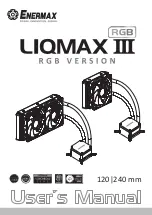
Thermal Solutions
40
Intel® Xeon® Processor E5-2400 Product Family
Thermal/Mechanical Design Guide
5.6.3
Intel® Turbo Boost Technology
Intel® Turbo Boost Technology (Intel®
TBT), available on certain processor SKUs,
opportunistically, and automatically, allows the processor to run faster than the marked
frequency if the part is operating below its power, temperature and current limits.
Heatsink performance (lower
Ψ
CA
as described in
) is one of several
factors that can impact the amount of Intel TBT frequency benefit. Intel TBT
performance is also constrained by ICC, and VCC limits.
Increased IMON accuracy may provide more Intel TBT benefit on TDP limited
applications, as compared to lower
Ψ
CA
, as temperature is not typically the limiter for
these workloads.
With Intel TBT enabled, the processor may run more consistently at higher power levels
(but still within TDP), and be more likely to operate above T
CONTROL
, as compared to
when Intel TBT is disabled. This may result in higher acoustics.
5.7
Thermal Guidance
5.7.1
Thermal Excursion
Under fan failure or other anomalous thermal excursions, Tcase may exceed the
thermal profile for a duration totaling less than 360 hours per year without affecting
long term reliability (life) of the processor. For more typical thermal excursions,
Thermal Monitor is expected to control the processor power level as long as conditions
do not allow the Tcase to exceed the temperature at which Thermal Control Circuit
(TCC) activation initially occurred. Under more severe anomalous thermal excursions
when the processor temperature cannot be controlled at or below this Tcase level by
TCC activation, then data integrity is not assured. At some higher threshold,
THERMTRIP_N will enable a shut down in an attempt to prevent permanent damage to
the processor. Thermal Test Vehicle (TTV) may be used to check anomalous thermal
excursion compliance by ensuring that the processor Tcase value, as measured on the
TTV, does not exceed Tcase_max at the anomalous power level for the environmental
condition of interest. This anomalous power level is equal to 75% of the Thermal
Design Power (TDP) limit.
This guidance can be applied to 95W, 80W, 70W, 60W Standard or Basic SKUs in the
Intel® Xeon® Processor E5-2400 Product Family.
5.7.2
Absolute Processor Temperature
Intel does not test any third party software that reports absolute processor
temperature. As such, Intel cannot recommend the use of software that claims this
capability. Since there is part-to-part variation in the TCC (thermal control circuit)
activation temperature, use of software that reports absolute temperature can be
misleading.
See the appropriate Datasheet for details regarding use of TEMPERATURE_TARGET
register to determine the minimum absolute temperature at which the TCC will be
activated and PROCHOT# will be asserted.
Содержание Xeon E5-2400
Страница 8: ...8 Intel Xeon Processor E5 2400 Product Family Thermal Mechanical Design Guide ...
Страница 12: ...Introduction 12 Intel Xeon Processor E5 2400 Product Family Thermal Mechanical Design Guide ...
Страница 22: ...LGA1356 Socket 22 Intel Xeon Processor E5 2400 Product Family Thermal Mechanical Design Guide ...
Страница 44: ...Thermal Solutions 44 Intel Xeon Processor E5 2400 Product Family Thermal Mechanical Design Guide ...
Страница 84: ...Mechanical Drawings 84 Intel Xeon Processor E5 2400 Product Family Thermal Mechanical Design Guide ...
Страница 90: ...Socket Mechanical Drawings 90 Intel Xeon Processor E5 2400 Product Family Thermal Mechanical Design Guide ...
















































